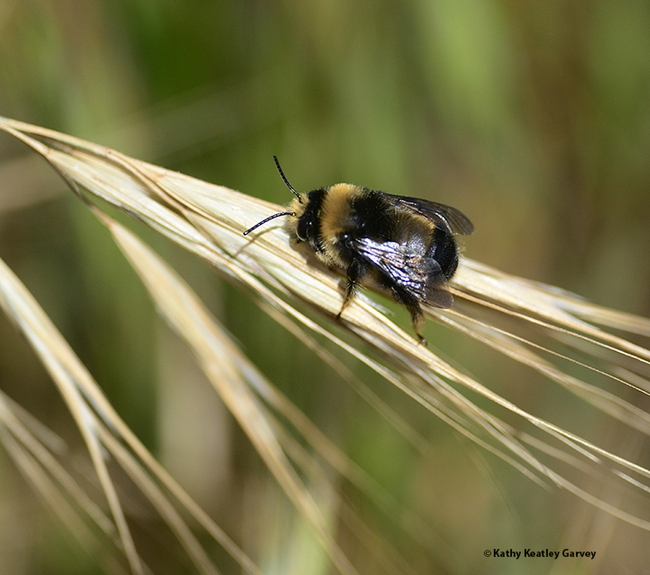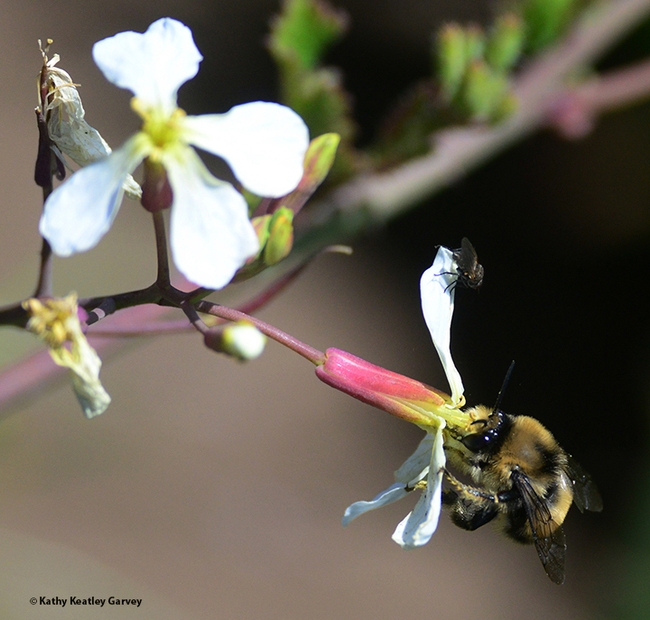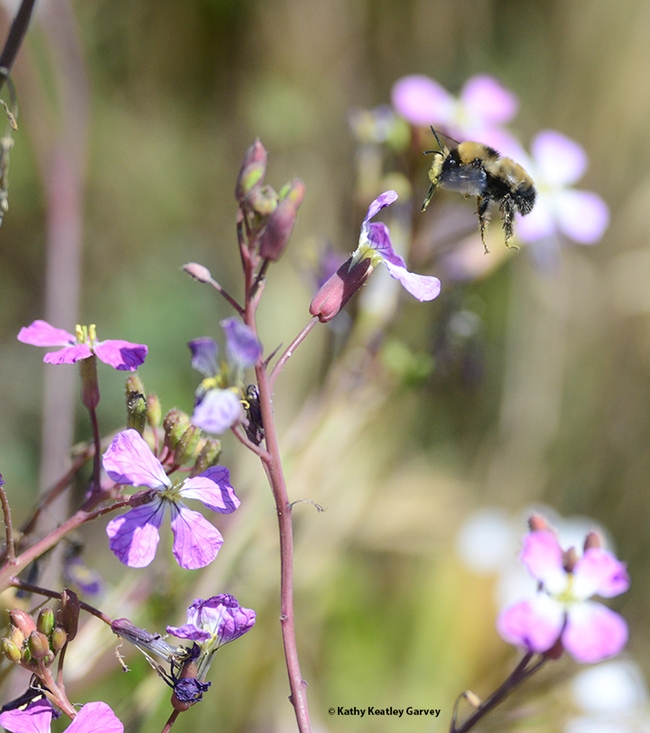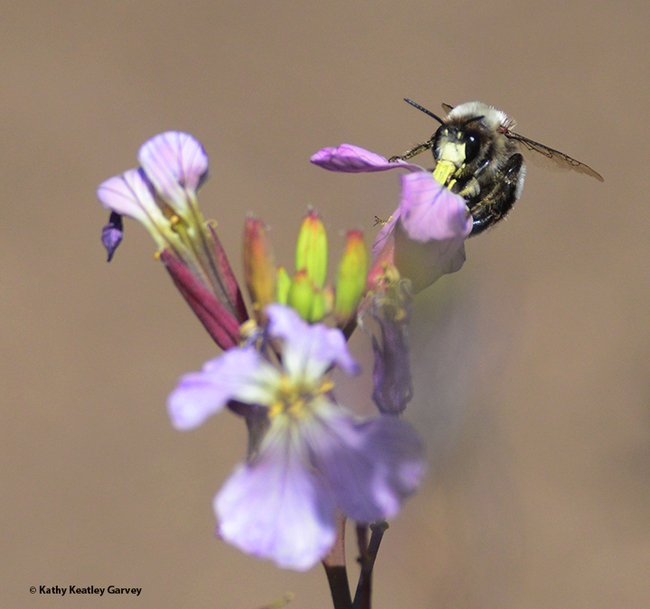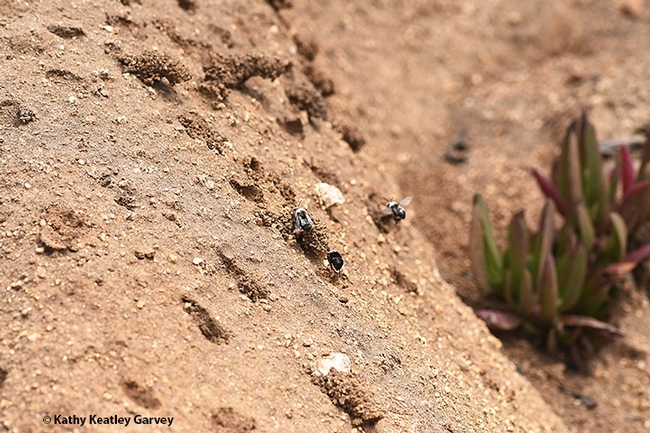- Author: Kathy Keatley Garvey
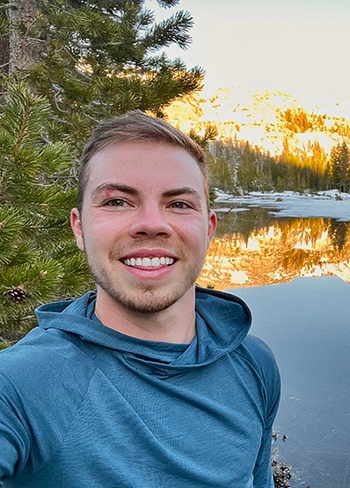
So when we viewed KQED's Deep Look video, “This Fly Torpedoes a Bindweed Bee's Nest,” on YouTube at https://youtu.be/gJHCoP4WqMc, we were totally amazed. It's nothing short of spectacular.
The crew filmed the bees in a nesting area outside the UC Davis Stebbins Cold Canyon Reserve, near Winters.
UC Davis scientists Shawn Christensen, a fifth-year doctoral candidate in the laboratory of community ecologist Rachel Vannette, UC Davis Department of Entomology and Nematology, were among those collaborating with the Deep Look production.
“Shawn has done a lot of work on this bee and with Deep Look, and he also leads our lab's work on Anthophora bomboides, a bumble bee mimic, and studies microbial associates of pollen and solitary bees,” said community ecologist and associate professor Rachel Vannette, a Chancellor's Fellow and vice chair of the Department of Entomology and Nematology.
The bees, also known as digger bees or chimney bees, are specialists on bindweed, commonly known as morning glory. “The females use pollen only from one plant species and are active through the late spring and early summer,” said Vannette, an international leader in microbial ecology who studies interactions between plants, insects and microbes.
Native to California, the bindweed turret bees dig underground nests, many with structures called turrets at the nest entrance. They provision the nests with pollen for their future offspring, and then lay their eggs inside.
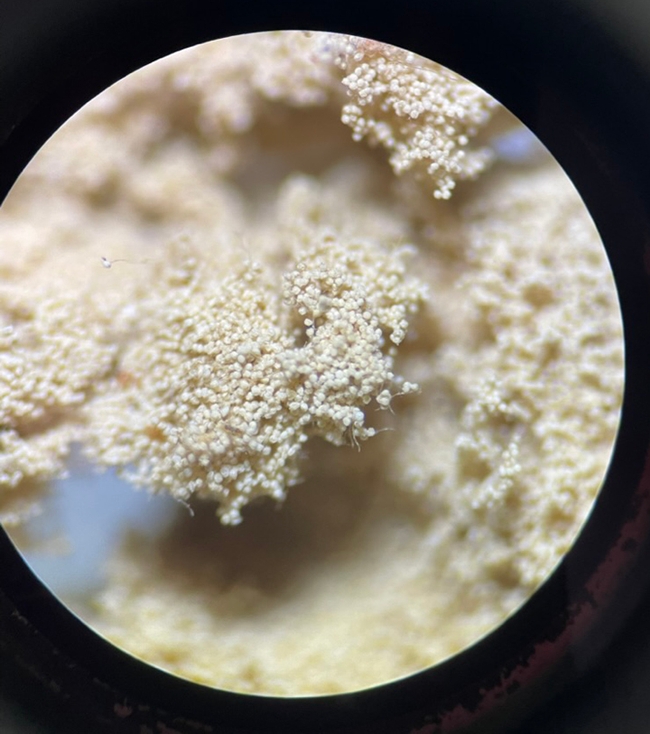
Quirós also consulted with seven other scientists: Stephen Buchmann, University of Arizona; Andy Calderwood, Ventura County Deputy Agricultural Commissioner; Neal Evenhuis, Bishop Museum of Honolulu, Hawaii; Paul Havemann, UC Davis Natural Reserve System; Keng-Lou James Hung, University of Oklahoma; Doug Yanega, UC Riverside, and James Carey, a naturalist who researches and videos bindweed turret bees in the Santa Monica Mountains National Recreational Area.
Josh Cassidy, the lead producer and cinematographer, filmed all the footage except for the male bees fighting with each other (00;17;14- 00;25;22 in the video). James Carey, who filmed that incredible footage, “has been regularly monitoring and filming bindweed turret bees since 2016 in Rancho Sierra Vista/Satwiwa, an open space in the Santa Monica Mountains,” Quirós said. “James also filmed the shot at 04;17-04;21 showing nests in the Santa Monica Mountains covered up at the end of the nesting season."
Christensen, a member of the UC Davis Microbiology Graduate Group and anticipating his doctorate in the spring of 2024, is an evolutionary biologist turned microbiologist. Christensen also researches other native bees, including Melissodes and Colletes.
Vannette focuses her research on the chemical and microbial ecology of plant-pollinator interactions and how microbes influence plant defense and resistance against insect pests. On its website, the Vannette lab is described as "a team of entomologists, microbiologists, chemical ecologists, and community ecologists trying to understand how microbial communities affect plants and insects--sometimes other organisms, too. We often study microbial communities in flowers, on insects or in soil. We rely on natural history observations, and use techniques from chemical ecology, microbial ecology and community ecology. In some cases, we study applied problems with an immediate application including pathogen control or how to support pollinators.”
We're looking forward to more research from the Vannette lab, including their work on Anthophora bomboides, a bumble bee mimic that forms turrets in sand dunes (including the sand cliffs at Bodega Head).
Most people are unaware that there are more than 20,000 known bee species in the world, and 4,000 of them are native to the United States. Of the 20,000 known bee species, 70 percent are ground-nesting bees. California alone is home to more than 1600 species.
And just one of those species is the bindweed turret bee, Diadasia bituberculata, that forages on morning glories. Glory bee...
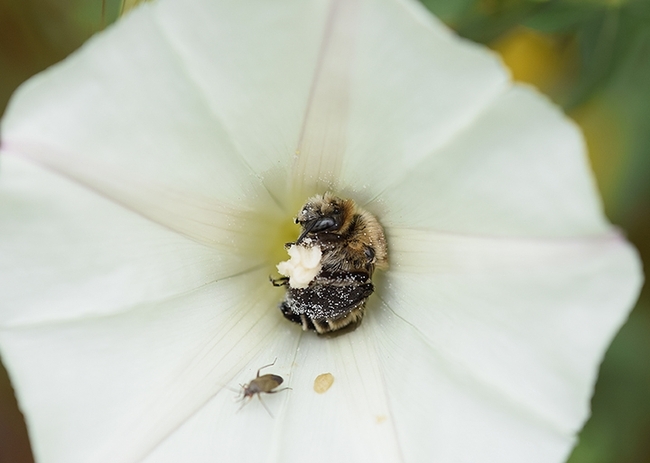
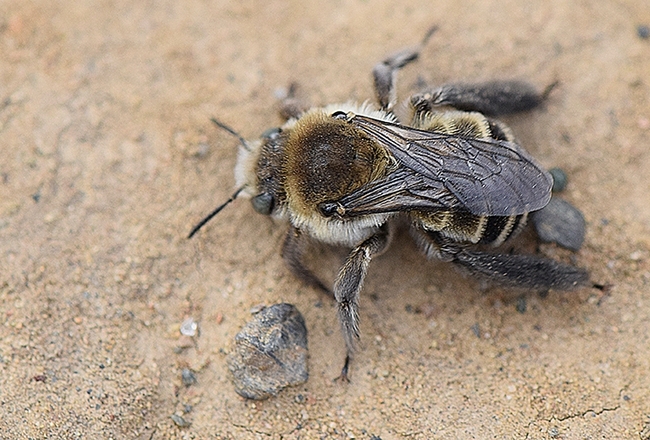
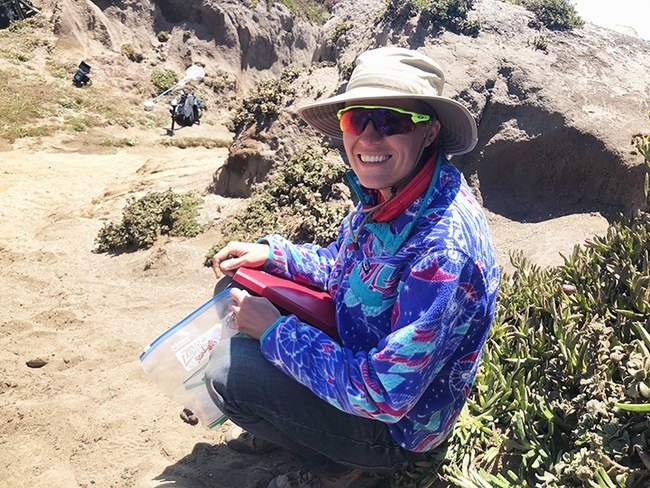
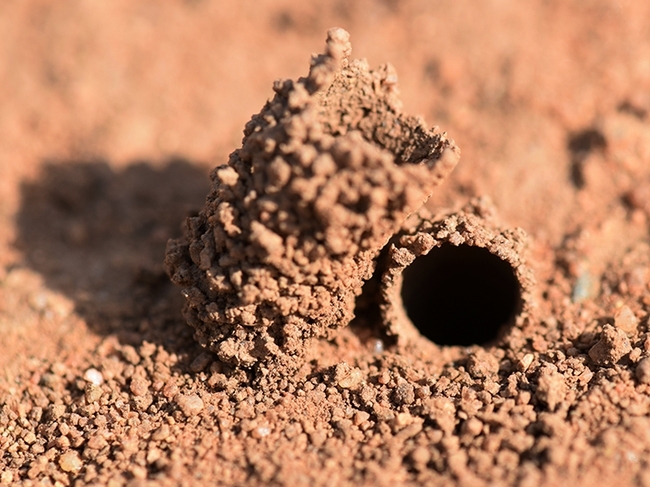
- Author: Kathy Keatley Garvey
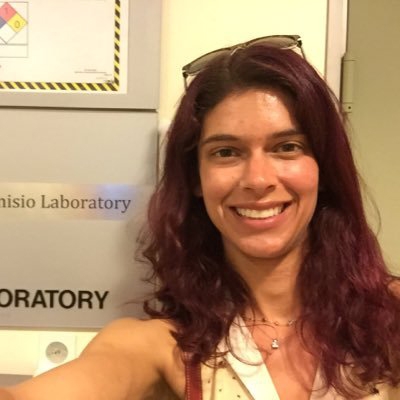
Ponisio, who grew up in Fresno and holds degrees from Stanford University and UC Berkeley, is an assistant professor of biology at the University of Oregon who seeks to preserve and restore populations of bees and other pollinators.
Her seminar, both in-person and virtual, is sponsored by the UC Davis Department of Entomology andNematology at 4:10 p.m., Wednesday, Feb. 8 in 122 Briggs Hall. Host is community ecologist Rachel Vannette, associate professor, UC Davis Department of Entomology and Nematology. The Zoom link:
https://ucdavis.zoom.us/j/95882849672.
"Infectious disease prevalence is among the top five drivers of global extinction, including in wild bees," Ponisio says in her abstract. "With the global decline of wild bees, our work aims to contribute to understanding how community characteristics shape infectious disease prevalence in plant-pollinator communities. Infectious parasites can influence host immunity, physiology, and reproduction. The sharing of floral resources is a common mode of disease transmission among pollinators."
"Increasing host aggregation on floral resources can increase disease prevalence, that is, amplification," Ponisio noted. "Conversely, high host species diversity---even if accompanied by host aggregation---may dilute infection. Because bees pick up parasites from flowers, but not all flowers transmit parasites equally, flower abundance and diversity may further contribute to parasite dilution. In three systems, mass-blooming sunflower in Yolo County, CA, harvested forests in Coast Range, OR, and high elevation meadows across the Southwestern U.S., I examine how the factors that shape plant-pollinator abundance and diversity and the ramifications for parasite prevalence in wild bee communities. Across all systems, more than 40% of bees have at one parasite. Both natural (phenology) and human-induced (years post-harvest, mass-blooming crops) modification of the bee and floral communities indirectly affected parasitism by altering host community characteristics. I found a consistent amplification effect of host (bee) abundance and detected dilution through either host diversity or floral diversity in each system."
On her website, Ponisio elaborates: "We focus on understanding the mechanisms by which species interactions maintain species diversity, and how we can harness these processes to manage and restore diversity in human-modified systems. We focus on pollinators because they are critical for pollination in managed and natural plant communities, but our research is broadly applicable across ecological interactions. Our aim to discover new insights into how communities form, evolve, and persist through time and space, aiding in the prediction and prevention of community collapse. We combine modeling, synthesis and field-based work, and adhere to the principles of reproducible, open science."
Lauren holds two degrees from Stanford: a bachelor's degree in biology, with honors, in ecology and evolution (2010) and her master's degree in biology (2011). She received her doctorate from the Department of Environmental Science Policy and Management, UC Berkeley, in 2016.
Ponisio conducted postdoctoral research at UC Berkeley and served on the faculty at UC Riverside before accepting her current position. She received graduate fellowships from the National Science Foundation and the National Institute for Food and Agriculture, as well as a postdoctoral fellowship from the Berkeley Institute for Data Science. She was named among the Global Food Initiative's “30 Under 30” in Food Systems in 2016.
Food Gone. Ponisio says one of her most difficult field work experiences occurred in Yosemite National Park, according to her People Behind the Science podcast. "Their study on the effects of fires on pollinators required them to backpack out to remote sites where there had been natural fires. Lauren started working months ahead of time to get ready for the trip and prepare dehydrated meals for the lab to eat. One day, they opened the large canister where they had been storing their food to protect it from bears, and they discovered the food was gone. All that was left was a handwritten note from someone thanking them for leaving out food."
"The next day, the lab's field assistant tripped over a log and sprained her ankle. Then they accidentally left their sampling gear at a site and had to hike all the way back to retrieve it. Later, a bear came into their campsite and destroyed many of the traps they needed to collect pollinators for their study. At this point, Lauren and her colleagues were exhausted, surviving on snacks, their field assistant could barely walk, and much of the equipment they needed had been destroyed. In the face of all of these challenges, Lauren stayed calm. These kinds of things happen in field research, and everyone made it back to share the story."
Ponisio was featured on National Public Radio's "All Things Considered" in January of 2021 when she discussed "Wildfires Open Forests for Wildlife and Research."
Ponisio is the lead author of a recently submitted journal paper, "Mass-Flowering Crops Attract Bees, Amplifying Parasitism," co-authored by G. P. Smith, H. Sardinas, J. Zorn, Q. S. McFrederick and S. H.Woodard. (See CV)
The UC Davis Department of Entomology and Nematology's winter seminars are held on Wednesdays at 4:10 p.m. in 122 Briggs Hall. All are virtual. They are coordinated by urban landscape entomologist Emily Meineke, assistant professor. (See schedule.) She may be reached at ekmeineke@ucdavis.edu for technical issues.
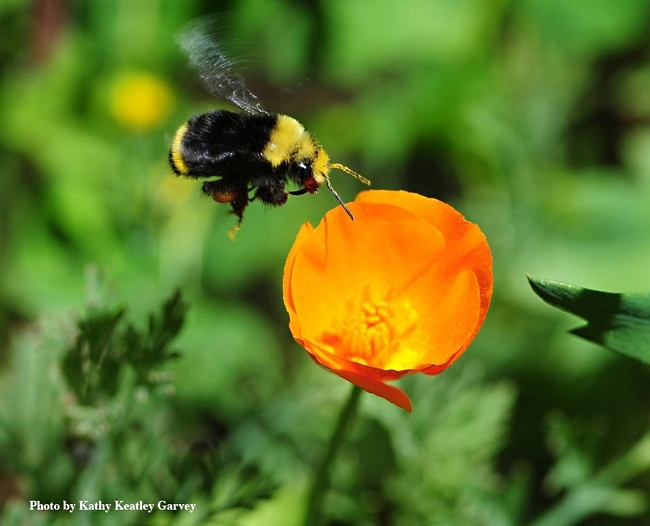
- Author: Kathy Keatley Garvey
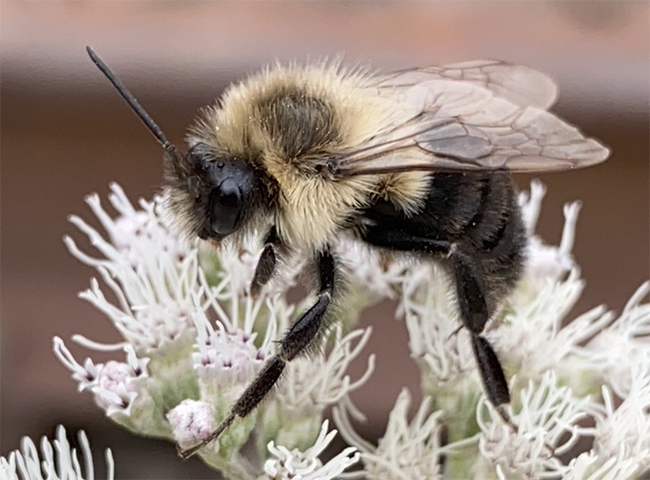
With the Entomological Society of America (ESA), however, being framed is a good thing. No, a great thing!
ESA honors its President's Prize winners (aka first-place winners) in the student research competitions by asking them to step behind a cardboard cut-out and smile for the camera. Voila! Suitable for framing!
Joe Rominiecki, ESA manager of communications, just announced that the images are now available and we have permission to share them.
We earlier wrote that doctoral candidates Danielle Rutkowski and Zachary Griebenow of the UC Davis Department of Entomology and Nematology each won the President's Prize for their individual research presentations at the 2022 Joint Meeting of the Entomological Societies of America, Canada, and British Columbia, held Nov. 13-16 in Vancouver, British Columbia.
And now, we have the images.
Background: At the annual ESA meetings, students are offered the opportunity to present their research and win prizes. They can compete in 10-minute papers (oral), posters, or infographics. The President's Prize winners receive a one-year paid membership in ESA, a $75 cash prize, and a certificate. Second-winners score a one-year free membership in ESA and a certificate.
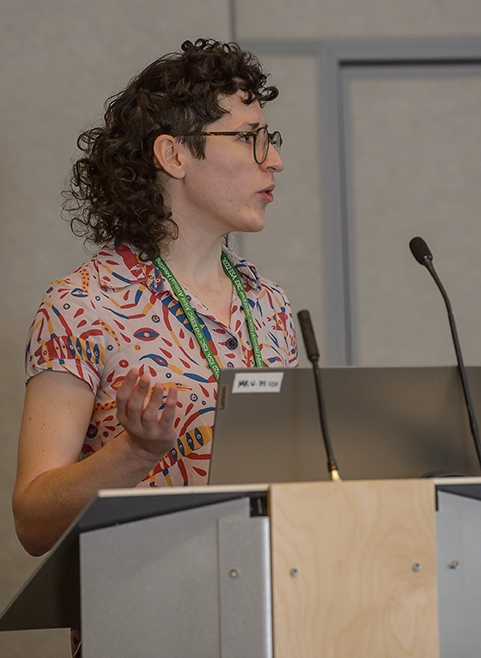
Rutkowski, who studies with community ecologists Rachel Vannette, associate professor, and distinguished professor Richard “Rick” Karban, spoke on “The Mechanism Behind Beneficial Effects of Bee-Associated Fungi on Bumble Bee Health,” at her presentation in the category, Graduate School Plant-Insect Ecosytems: Pollinators.
Her abstract: "Bees often interact with fungi, including at flowers and within bee nests. We have previously found that supplementing bumble bee colonies with these bee-associated fungi improves bee survival and increases reproductive output, but the mechanisms behind these effects are unclear. This research aimed to determine the mechanisms underlying positive impacts of fungal supplementation in the bumble bee, Bombus impatiens. We tested two hypotheses regarding possible nutritional benefits provided by bee-associated fungi. These included the role of fungi as a direct food source to bees, and the production of nutritionally important metabolites by fungi. To test these mechanisms, we created microcolonies bumble bees and exposed each microcolony to one of four treatment groups. These four treatments were created based on the presence of fungal cells and the presence of fungal metabolites. We found that bee survival and reproduction were unaffected by treatment, with trends of decreased survival and reproduction when fungi were present. This contradicts previous results we've found using this bumble bee species, where fungi had a positive impact. It is possible that this disparity in results is due to differences in pathogen pressure between the two experiments, as bees in the first experiment were exposed to large amounts of pathogen through provided pollen, including Ascosphaera and Aspergillus. This pollen was sterilized for subsequent experiments, reducing pathogen load. Therefore, it is possible that bee-associated fungi benefit bees through pathogen inhibition, and future work exploring this hypothesis is necessary to fully understand the role of these fungi in bumble bee health."
Zachary Griebenow. Griebenow, who studies with major professor and ant specialist Phil Ward, (Griebenow also captained the UC Davis Entomology Games Team in its national championship win at the Entomology Games or Bug Bowl) explained “Systematic Revision of the Obscure Ant Subfamily Leptanillinae (Hymenoptera: Formicidae), Reciprocally Informed by Phylogenomic Inference and Morphological Data.” His category: Graduate School Systematics, Evolution and Biodiversity: Evolution 1.
His abstract: "Ants belonging to the subfamily Leptanillinae (Hymenoptera: Formicidae) are sister to nearly all other extant ants. Miniscule and subterranean, little is known of their behavior. Contrary to the collecting bias observed in most ants, male leptanilline specimens are acquired more easily than workers or queens. The sexes are almost never collected in association, and many subclades within the Leptanillinae are known from male specimens only. Our comprehension of evolutionary relationships among the Leptanillinae is further obstructed by oft-bizarre derivation in male phenotypes that are too disparate for phylogeny to be intuited from morphology alone. These restrictions plague our understanding of the Leptanillinae with probable taxonomic redundancy. My thesis aims at leptanilline taxonomy that reflects phylogeny, inferred from both genotype and phenotype, and integrates morphological data from both sexes. Here I present the results of (1) phylogenomic inference from ultra-conserved elements (UCEs), compensating for potential systematic biases in these data, representing 63 terminals; and (2) Bayesian total-evidence inferences from a handful of loci, jointly with discrete male morphological characters coded in binary non-additive or multistate fashion. Notably, these analyses identify worker specimens belonging to the genera Noonilla and Yavnella, which were heretofore known only from males. Given such discoveries across the Leptanillinae, the number of valid leptanilline genera is reduced from seven to three in order to create a genus-level classification that upholds monophyly along with diagnostic utility."
We also salute our second-place winners (see previous news story:
- Lindsey Mack, who studies with medical entomologist-geneticist Geoffrey Attardo, assistant professor, covered “Three Dimensional Analysis of Vitellogenesis in Aedes aegypi Using Synchrotron X-Ray MicroCT” in the category, Graduate School Physiology, Biochemistry and Toxicology: Physiology
- Addie Abrams, who studies with Extension agricultural entomologist and assistant professor Ian Grettenberger, titled her research, “Hitting the Mark: Precision Pesticide Applications for the Control of Aphids in California Lettuce" in the category, Graduate School Physiology, Biochemistry and Toxicology: Integrated Pest Management
Congrats, all! They do our department and our university proud!
(The 7000-member ESA, founded in 1889, is the largest organization in the world serving the professional and scientific needs of entomologists and individuals in related disciplines. Its members, affiliated with educational institutions, health agencies, private industry, and government, are researchers, teachers, extension service personnel, administrators, marketing representatives, research technicians, consultants, students, pest management professionals, and hobbyists.)
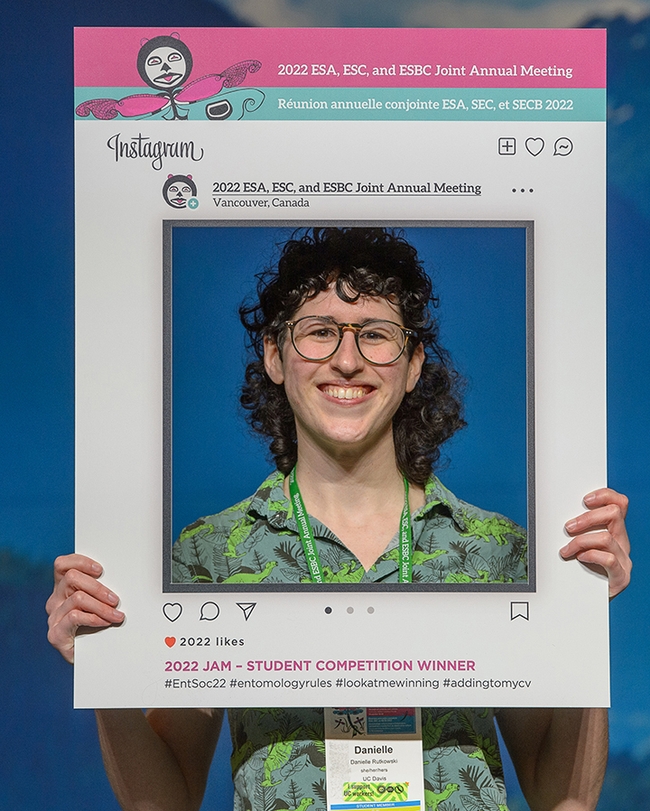
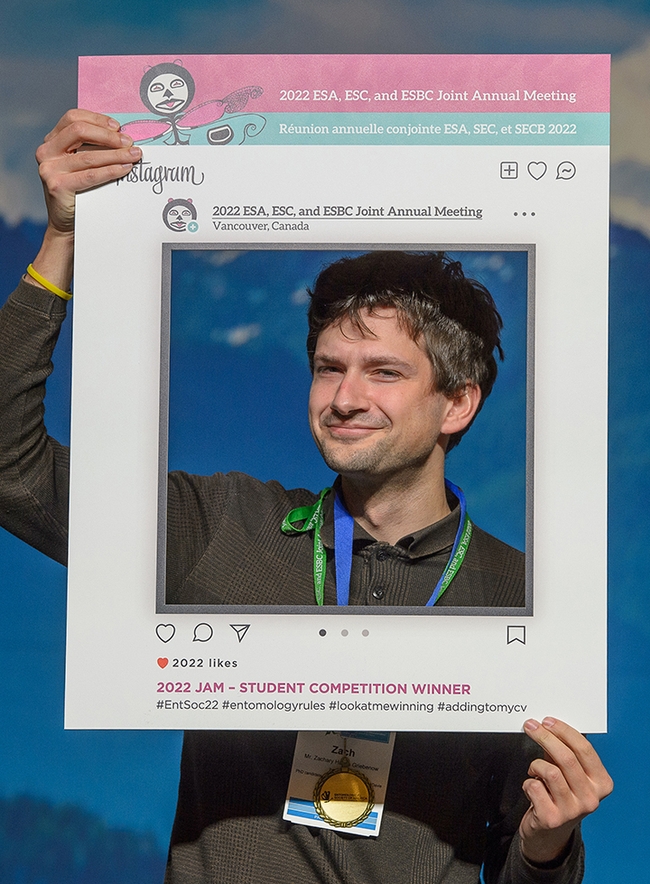
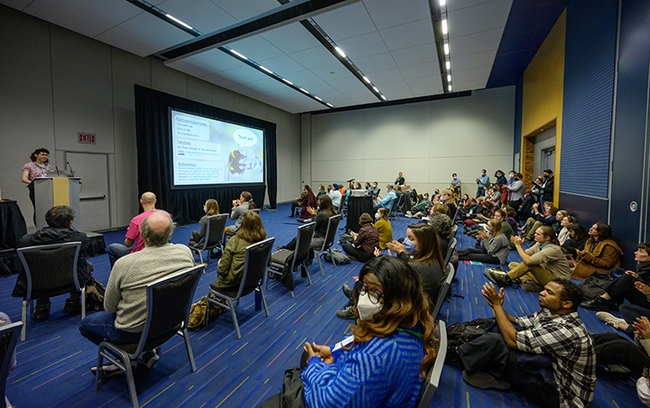
- Author: Kathy Keatley Garvey
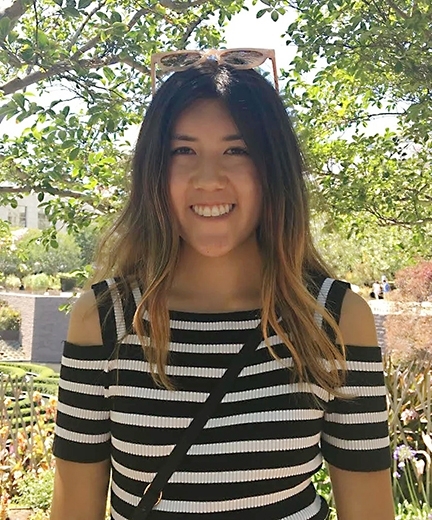
A recent example: RSPIB scholar Madeline Handy, an undergraduate student and research intern in the laboratory of community ecologist Rachel Vannette, originated the research about exploring gut bacteria in carpenter bees and the results are now published in the journal Molecular Ecology.
Gut bacteria of two carpenter bee species shows a surprising find: their gut bacteria is more similar to social bees like honey bees and bumble bees than to solitary bees, even to closely related bee species. Unlike honey bees, carpenter bees do not live in hives, they have no queen and they do not produce honey.
The work focused on two species of carpenter bees, the Valley carpenter bee or Xylocopa sonorina, and the mountain carpenter bee, Xylocopa tabaniformis, from multiple geographic sites in their range, said Vannette, corresponding author and an associate professor in the UC Davis Department of Entomology and Nematology.
The research suggests that “sociality may not be the main driver of microbiome structure in bees as is often assumed,” Vannette said.
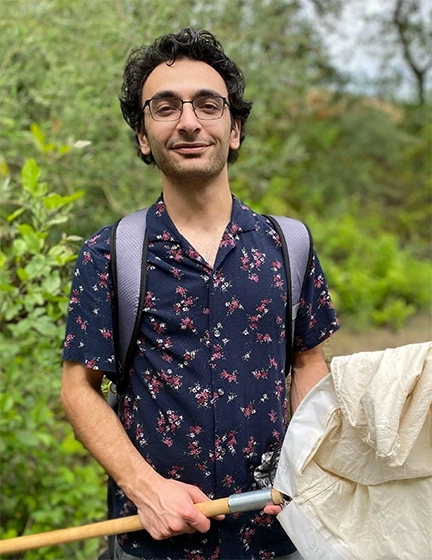
“Maddie sampled carpenter bees from Davis--with locations crowdsourced using NextDoor--and she traveled to Anza Borrego to sample bees from this preserve, under a grant supported by the University of California's Natural Reserve System,” Vannette related. “We also received samples from collaborators in Tucson so that we could compare if the microbiome of the two carpenter bee species differed across a broad range in the southwest United States.”
The researchers sequenced the microbial communities “using technology that produces longer reads from microbial DNA and allows us to get a better picture of the microbes that are found in the crop and gut, as well as their relatedness to each other,” Vannette said.
“We found that bacterial species in the gut are consistent and predictable among individual bees while bacteria in the crop are more variable and reflect what the bees have been eating.” Vannette said. “We also found that the main gut bacteria were found in bees throughout the range of the species. The surprising part was that carpenter bees are not eusocial yet their gut contains a microbiome of a social bee. We speculate that carpenter bee's long lives and limited social interactions, may help to maintain this consistent and 'social' microbiome.”
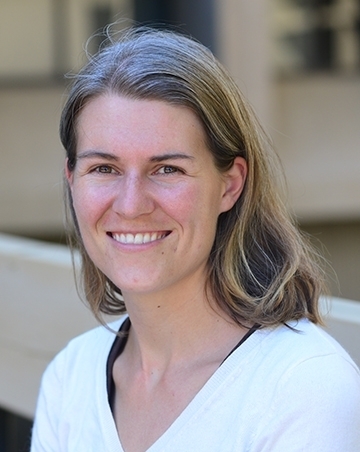
Next Steps. The next steps? “We would love to know what are these bacteria doing and if they are beneficial to bees. Our lab is excited to explore how bacterial and fungal communities in bee GI tract, stored food and other insect life stages like larvae or pupae may contribute to bee nutrition and health.”
The six-member team also included co-authors Michael Yu, UCLA Department of Ecology and Evolutionary Biology; Nicholas Saleh, Department of Entomology and Nematology Fort Lauderdale Research and Education Center, University of Florida, Davie; and Madeleine M. Ostwald, School of Life Sciences, Arizona State University, Tempe.
Their paper is titled “Incipiently Social Carpenter Bees (Xylocopa) Host Distinctive Gut Bacterial Communities and Display Geographical Structure as Revealed by Full-Length PacBio 16S rRNA Sequencing.”
Abstract:
“The gut microbiota of bees affects nutrition, immunity and host fitness, yet the roles of diet, sociality and geographical variation in determining microbiome structure, including variant-level diversity and relatedness, remain poorly understood. Here, we use full-length 16S rRNA amplicon sequencing to compare the crop and gut microbiomes of two incipiently social carpenter bee species, Xylocopa sonorina and Xylocopa tabaniformis, from multiple geographical sites within each species' range. We found that Xylocopa species share a set of core taxa consisting of Bombilactobacillus, Bombiscardovia and Lactobacillus, found in >95% of all individual bees sampled, and Gilliamella and Apibacter were also detected in the gut of both species with high frequency. The crop bacterial community of X. sonorina comprised nearly entirely Apilactobacillus with occasionally abundant nectar bacteria. Despite sharing core taxa, Xylocopa species' microbiomes were distinguished by multiple bacterial lineages, including species-specific variants of core taxa. The use of long-read amplicons revealed otherwise cryptic species and population-level differentiation in core microbiome members, which was masked when a shorter fragment of the 16S rRNA (V4) was considered. Of the core taxa, Bombilactobacillus and Bombiscardovia exhibited differentiation in amplicon sequence variants among bee populations, but this was lacking in Lactobacillus, suggesting that some bacterial genera in the gut may be structured by different processes. We conclude that these Xylocopa species host a distinctive microbiome, similar to that of previously characterized social corbiculate apids, which suggests that further investigation to understand the evolution of the bee microbiome and its drivers is warranted.”
Handy, who is pursuing her master's degree in public health, says her interest is “in all things microbiome, but I'm particularly interested in women's health and nutrition when it comes to the microbes living in our bodies.”
Sbardellati is interested in understanding how microbial ecology shapes macroscale ecology. In the Vannette lab, he studies bacteriophage (viruses which target bacteria) communities associated with the bumble bee gut and how phages shape gut microbial communities.
The Vannette lab is a team of entomologists, microbiologists, chemical ecologists, and community ecologists trying to understand how microbial communities affect plants and insects, and sometimes other organisms as well.
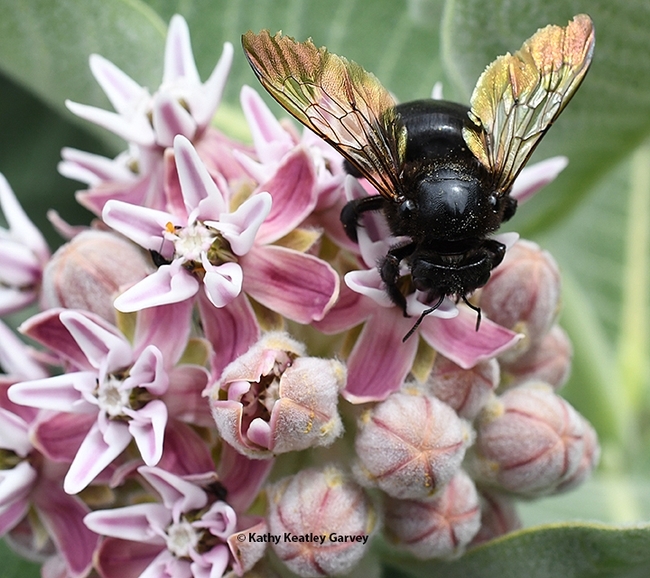
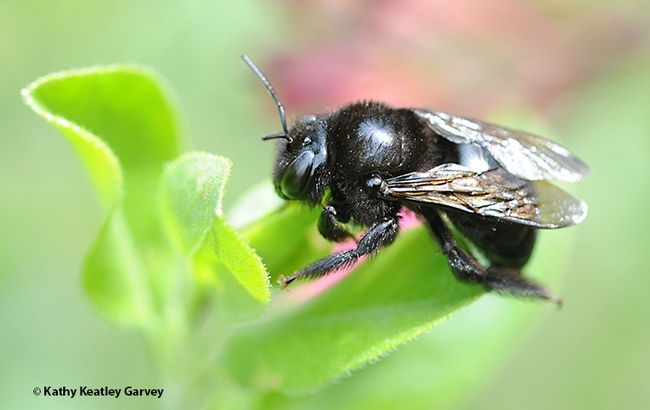
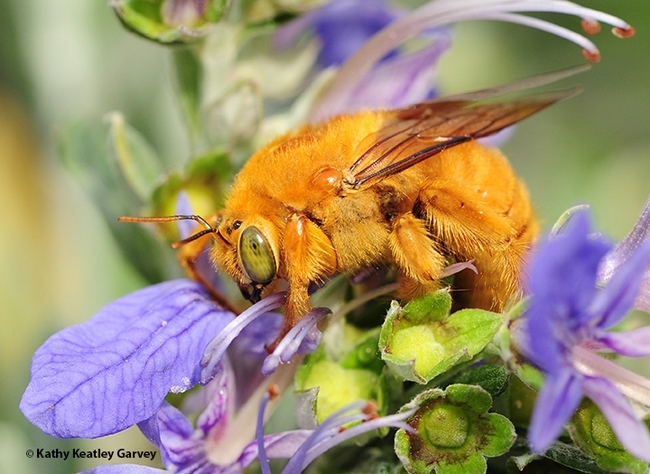
- Author: Kathy Keatley Garvey
If you've ever been to Bodega Head in Sonoma County, you may have marveled at the waves crashing and the whales surfacing.
But have you ever seen the digger bees, Anthophora bomboides stanfordiana, aka bumble bee mimics, that nest in the sandstone cliffs?
They're there. They're foraging on flowers, excavating their nests, and rearing young.
These digger bees are not easy to photograph. On our May 9th trip, we got lucky: our 200mm macro lens picked up a digger bee warming its flight muscles.
"The species name indicates that it is a bumble bee mimic," the late Robbin Thorp (1933-2019), a global authority on bumble bees and a UC Davis distinguished emeritus professor of entomology. "These bees need a source of fresh water nearby. Females suck up water, regurgitate it on the sandstone bank surface, then dig away at the soft mud. They use some of the mud to build entrance turrets, presumably to help them locate their nests within the aggregation of nests."
"The female," Thorp said, "sucks up fresh water from nearby, stores it in her crop (like honey bees store nectar) for transport to the nest. She regurgitates it on the sandstone, and excavates the moistened soil. She carries out the mud and makes the entrance turret with it."
Thorp, a 30-year member of the Department of Entomology and Nematology, studied these bees. (See his presentation at the Proceedings of the Symposium on Biodiversity of Northwestern California, Santa Rosa, delivered in October 1991.)
Today, community ecologist and associate professor Rachel Vannette from the same department, is among scientists engaged in the research of these fascinating bees.
